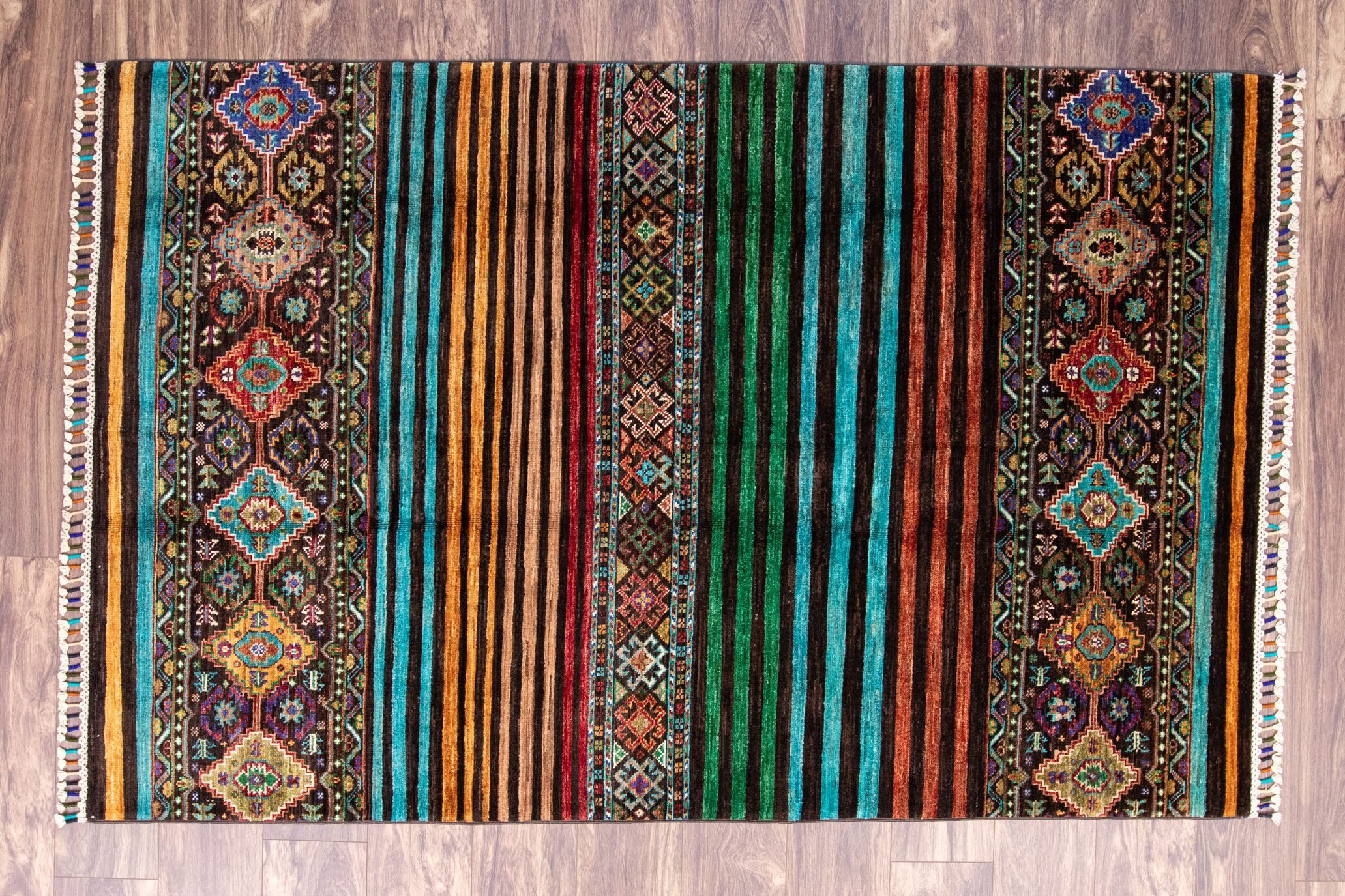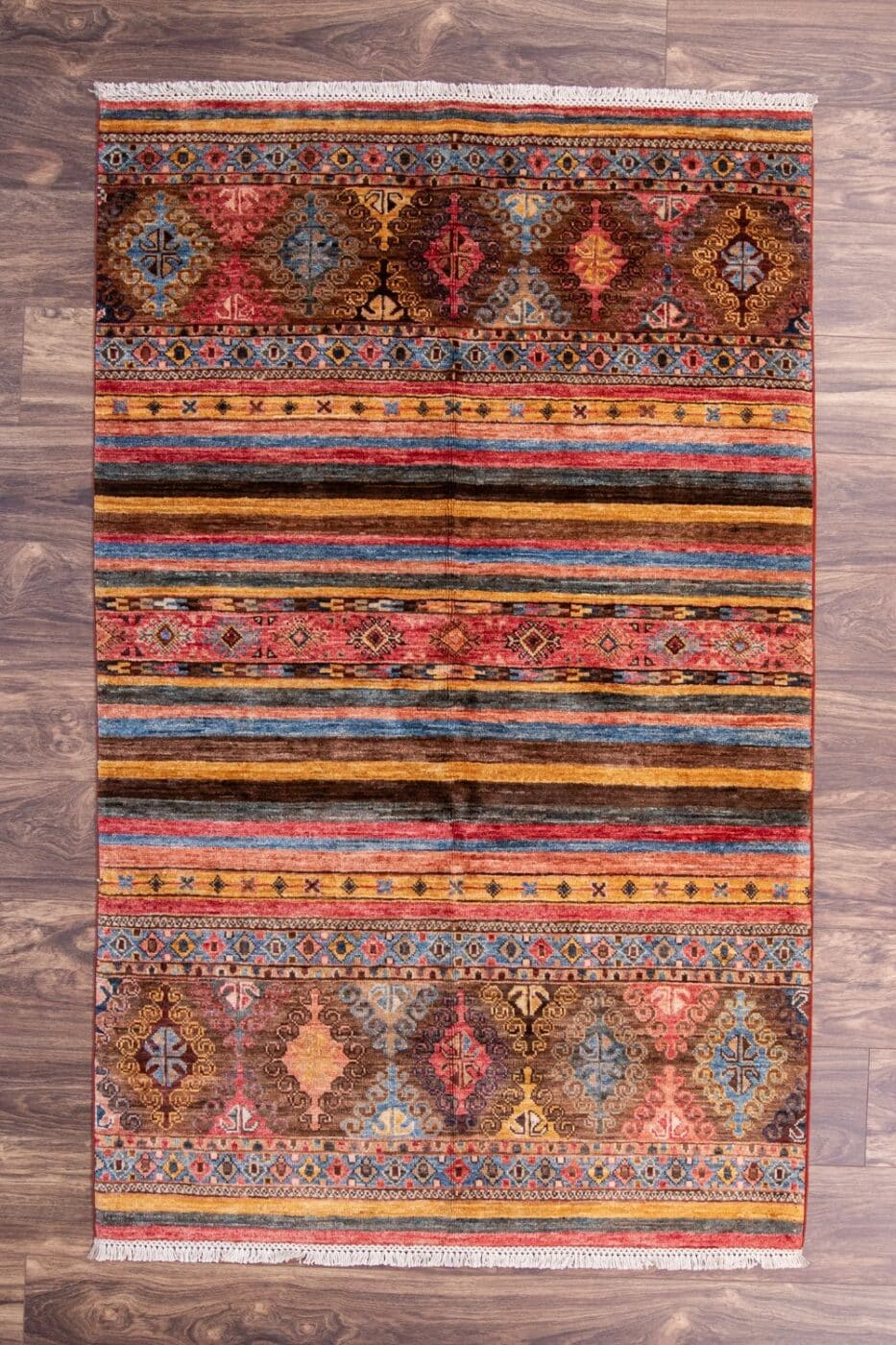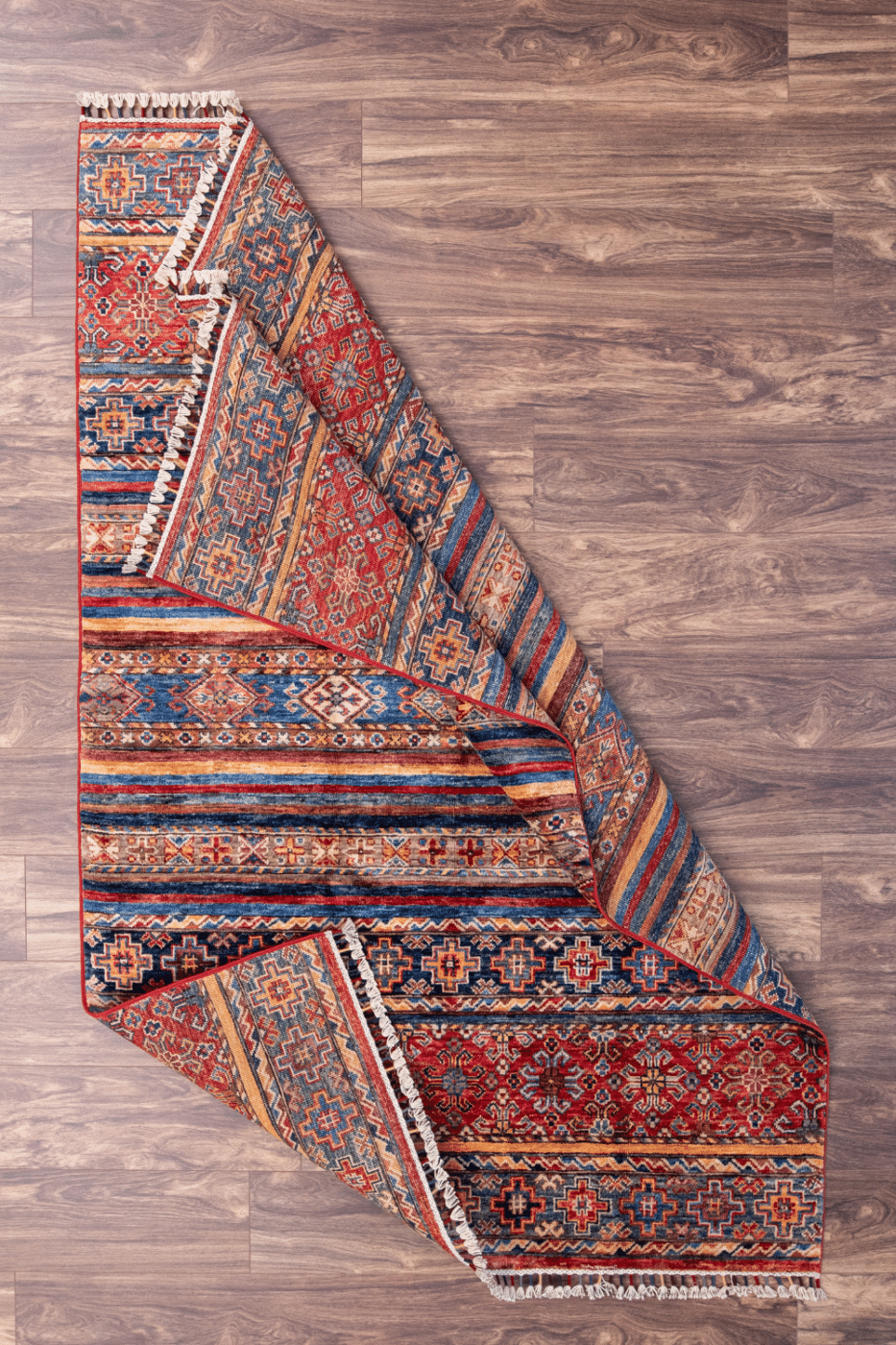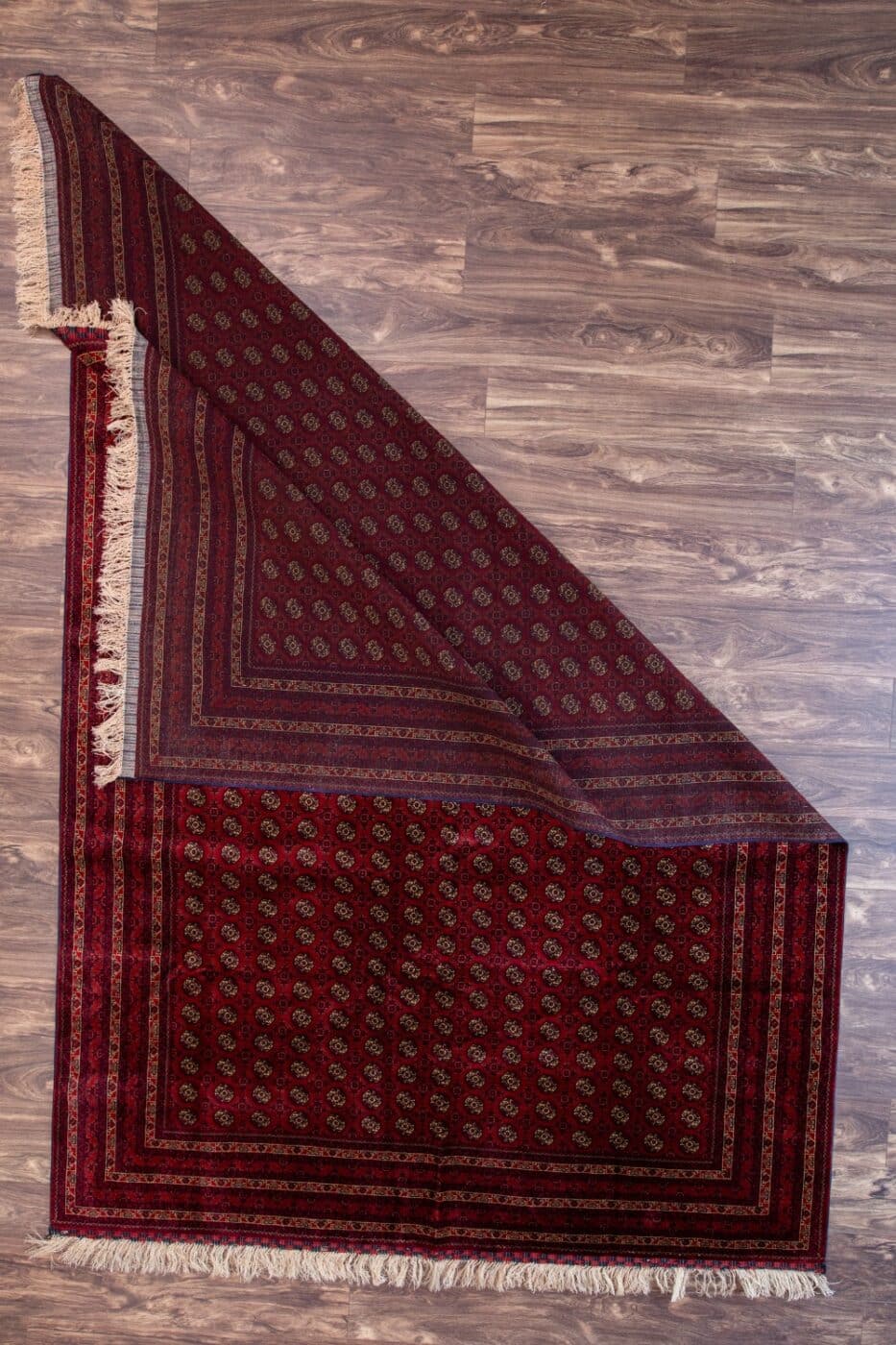Discover the Diverse Styles of Afghan Rugs

Afghan rugs are known for their exceptional craftsmanship, intricate designs, and rich cultural heritage. Each style reflects the unique history and traditions of the tribes and regions from which they originate. Here’s a closer look at some of the most notable styles of Afghan rugs.
1. Kazak Rugs

Kazak rugs are celebrated for their bold, geometric patterns and vibrant colors, including rich reds, blues, and gold. These rugs often feature large medallions, crosses, and star motifs, reflecting the tribal and nomadic influences of the Caucasus region. Made with high-quality wool, Kazak rugs are known for their durability and luxurious feel. Their striking designs and rich hues make them a focal point in any room.
- Patterns and Motifs: The geometric designs often include diamond shapes, hooked motifs, and symbolic representations of protection and strength.
- Materials and Techniques: Hand-knotted using wool with natural dyes that create deep, lasting colors.
- Origin and History: While named after the Kazak people, these rugs are traditionally made in the Caucasus region, influenced by the diverse cultures and tribes of the area.
2. Mamluk Rugs

Mamluk rugs are well-known for their intricate geometric patterns and ornamental designs, typically arranged around a central medallion. These designs use a rich color palette that includes turquoise, amber, and terra cotta. Originating from the Mamluk dynasty in Egypt, these rugs carry significant historical and cultural value. Known for their high knot density and exceptional craftsmanship, Mamluk rugs are a testament to meticulous artistry and heritage.
- Patterns and Motifs: Featuring star-shaped medallions, intricate vine work, and complex, symmetrical designs.
- Materials and Techniques: High knot density, often exceeding 100 knots per square inch, crafted with wool or a blend of wool and silk.
- Origin and History: Originated during the Mamluk Sultanate in Egypt (1250-1517), reflecting Islamic art and architecture.
3. Khorjin Rugs

Inspired by traditional saddlebag designs used by nomadic tribes, Khorjin rugs feature vibrant colors and bold patterns, often incorporating stripes and geometric motifs. Made with hand-spun wool and natural dyes, these rugs are prized for their unique, rustic charm and practicality. Their design reflects a blend of functionality and aesthetic appeal, making them a versatile choice for various interior styles.
- Patterns and Motifs: Stripes, zigzags, and small medallions, often arranged in a patchwork-like fashion.
- Materials and Techniques: Hand-spun wool with vegetable dyes, giving them a natural and earthy appearance.
- Origin and History: Rooted in the practical needs of nomadic tribes, these rugs reflect a blend of utility and artistry.
4. Baluchi Rugs
Baluchi rugs, crafted by the Baluch tribes, are known for their small, portable sizes, ideal for nomadic lifestyles. They often feature deep, earthy colors like dark reds, browns, and blues, with intricate patterns that include prayer rug designs and repeating motifs. The compact size and detailed craftsmanship of Baluchi rugs make them perfect for adding a touch of authenticity and warmth to smaller spaces.
- Patterns and Motifs: Stripes, zigzags, and small medallions, often arranged in a patchwork-like fashion.
- Materials and Techniques: Hand-spun wool with vegetable dyes, giving them a natural and earthy appearance.
- Origin and History: Rooted in the practical needs of nomadic tribes, these rugs reflect a blend of utility and artistry.
5. Chobi/Ziegler Rugs
Chobi or Ziegler rugs are renowned for their soft, muted color palettes and elegant designs. These rugs often feature floral and vine motifs, with a distressed, antique look achieved through a special dyeing process. Their versatility allows them to blend seamlessly with traditional and contemporary decor, making them a popular choice for homeowners seeking a timeless and sophisticated aesthetic.
- Patterns and Motifs: Floral patterns, vines, and palmettes, often with a symmetrical layout.
- Materials and Techniques: Made with hand-spun wool and natural dyes, washed to create a faded, antique look.
- Origin and History: Developed by Ziegler & Co. in the late 19th century to cater to Western tastes, blending Persian and Western aesthetics.
6. Ersari Rugs
Ersari rugs, woven by the Ersari Turkmen tribes, typically showcase large, bold guls (tribal medallions) and vibrant colors like red, orange, and brown. Known for their sturdy construction, Ersari rugs are often used as floor coverings and wall hangings. Their bold designs and vibrant colors make them standout pieces that add a touch of tribal elegance to any space.
- Patterns and Motifs: Large guls, octagonal medallions, and repetitive geometric patterns.
- Materials and Techniques: Made from high-quality wool, using traditional knotting techniques.
- Origin and History: Reflecting the heritage of the Ersari Turkmen tribes, these rugs are a symbol of tribal identity and craftsmanship.
7. Turkoman Rugs
Turkoman rugs are characterized by their repeating guls and geometric patterns, predominantly featuring a red color palette. Made by various Turkmen tribes, these rugs are known for their fine knotting and rich cultural heritage. The intricate patterns and dominant red hues of Turkoman rugs make them a symbol of tradition and craftsmanship, perfect for those who appreciate detailed and culturally significant decor.
- Patterns and Motifs: Guls in various shapes, often representing tribal emblems, set against a field of repeating geometric motifs.
- Materials and Techniques: Wool on wool or wool on cotton, with fine knotting techniques that enhance their detail.
- Origin and History: Created by Turkmen tribes such as the Tekke and Yomut, each with distinctive gul designs signifying their tribal affiliations.
8. Gabbeh Rugs
Gabbeh rugs are known for their simplicity and bold, often whimsical designs. These rugs feature large fields of color with minimal patterns, sometimes including animals or abstract shapes to tell a story. Made with thick, high-quality wool, Gabbeh rugs have a plush texture and are highly durable. Their playful and minimalist designs make them ideal for adding a cozy and artistic touch to modern interiors.
- Patterns and Motifs: Large color blocks, and minimalistic patterns, often depicting animals, plants, or abstract shapes.
- Materials and Techniques: Thick, plush wool, often dyed with natural, bright colors.
- Origin and History: Traditionally made by Qashqai and Luri tribes, Gabbeh rugs reflect a more personal and narrative style of weaving.
9. Herati Rugs
Herati rugs are recognized for their intricate, repeating diamond and floral patterns, usually in deep reds and blues. Known for their fine detailing and dense knotting, they are highly valued for their aesthetic appeal and durability. The detailed patterns and rich colors make these rugs a beautiful addition to any room, exuding elegance and tradition.
- Patterns and Motifs: The “Herati” pattern features a diamond motif with curled leaves or fish around it, repeated across the field.
- Materials and Techniques: High-quality wool, often dyed with natural colors, and tightly knotted for durability.
- Origin and History: These rugs are from the Herat region in Afghanistan and are a testament to the region’s rich weaving tradition.
10. Tabriz Rugs
Tabriz rugs are celebrated for their precise craftsmanship and intricate designs, often featuring central medallions surrounded by detailed floral and vine motifs. Named after the city of Tabriz, these rugs are known for their fine knot density and use of high-quality wool and silk. The color palette typically includes rich reds, blues, and beiges, making Tabriz rugs prized for their elegance and artistic value. Their exquisite designs and luxurious materials make them a statement piece in any sophisticated interior.
- Patterns and Motifs: Central medallions, intricate floral and vine patterns, and elaborate borders.
- Materials and Techniques: Made with a combination of wool and silk, featuring very high knot densities for detailed designs.
- Origin and History: Named after the city of Tabriz in Iran, these rugs reflect a blend of Persian artistry and craftsmanship.
Afghan rugs are more than just floor coverings, they are works of art that tell the story of their creators. Whether you are drawn to the bold patterns of Kazak rugs or the elegant designs of Tabriz rugs, each style offers a unique blend of beauty, history, and craftsmanship.
Orientiq Silk Road Carpets | Afghan Rugs

At Orientiq, we are proud to offer a collection of beautiful Afghan rugs, each chosen for its top-notch quality and genuine craftsmanship. Our rugs are made with the best materials and traditional methods, so you get a piece of history that adds beauty to your environment. Browse our wide variety of Afghan rug styles to find the perfect rug that matches your taste and decor. Visit our store to see our options of Afghan rugs. Make your space special with a stunning rug from Orientiq today!
Why Choose Afghan Rugs from Orientiq?
- Authentic Craftsmanship: Each Afghan rug in our collection is handmade by skilled artisans, ensuring that every piece is unique and of the highest quality.
- Rich Cultural Heritage: Afghan rugs are more than just decorative items, they are pieces of art that carry the rich history and traditions of the regions they come from.
- Durability and Longevity: Made with high-quality wool and natural dyes, these rugs are not only beautiful but also built to last, standing up to everyday use.
- Variety of Styles: Whether you prefer the bold patterns of Kazak rugs or the soft, elegant designs of Mamluk rugs, we have something to suit every style and taste.
- Enhance Any Space: From living rooms and bedrooms to office spaces, an Afghan rug can transform any space, adding warmth, color, and character.
How to Choose the Perfect Rug
Choosing the right rug for your home involves considering several factors:
- Color and Pattern: Think about the existing colors and patterns in your room. Do you want a rug that stands out or one that blends in?
- Material: Our rugs are made from high-quality wool, which is soft, durable, and easy to maintain.
- Style: From traditional to modern, our collection includes a range of styles to complement any decor.
Care and Maintenance Tips
To keep your Afghan rug looking its best:
- Regular Vacuuming: Vacuum your rug regularly to remove dirt and debris.
- Spot Cleaning: Blot spills immediately with a clean, dry cloth. Avoid using harsh chemicals.
- Professional Cleaning: For deep cleaning, consider hiring a professional rug cleaner to ensure your rug stays in great condition.


